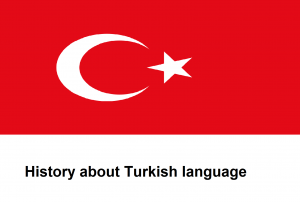Difference between revisions of "Language/Turkish/Culture/History"
(History about Turkish language) |
|||
| Line 1: | Line 1: | ||
[[File:Turkish | [[File:History about Turkish language.png|alt=History about Turkish language|thumb|History about Turkish language]] | ||
. | |||
Hello Everyone, 😊 | |||
In today’s lesson we are going to study the following topic: '''”HISTORY ABOUT TURKISH”''' in English | |||
Please feel free to edit this page if you think it can be improved! | |||
Good learning! | |||
. | |||
. | |||
== '''History about Turkish language''' == | |||
The Turkish language is said to be "agglutinating". It is composed of words to which will be added suffixes which are available in order to build the sentence and give it all its meaning. Atatürk deeply reformed it in 1928 to unite Turkish citizens around a single language | The Turkish language is said to be "agglutinating". It is composed of words to which will be added suffixes which are available in order to build the sentence and give it all its meaning. Atatürk deeply reformed it in 1928 to unite Turkish citizens around a single language | ||
Revision as of 05:22, 24 September 2021
.
Hello Everyone, 😊
In today’s lesson we are going to study the following topic: ”HISTORY ABOUT TURKISH” in English
Please feel free to edit this page if you think it can be improved!
Good learning!
.
.
History about Turkish language
The Turkish language is said to be "agglutinating". It is composed of words to which will be added suffixes which are available in order to build the sentence and give it all its meaning. Atatürk deeply reformed it in 1928 to unite Turkish citizens around a single language
The Turkish language is composed of words to which will be added suffixes which are declined (as in Latin or German) in order to build the sentence and give it all its meaning. A single word can thus constitute a complete sentence: "arkadaslarimlaydim" or "I was with my friends"! Turkish is also a very musical language to the ear because it follows the rule of vowel harmony between vowels without a dot (a, e, o, u, i) and with a dot (ö, ü, i), and hard (t, p, f, s, k, ç?) and soft (d, ..) consonants. We will say for example Paris'te, but Istanbul'da (in Paris, in Istanbul). Simple isn't it? .... But where does this language come from?
Turkish belongs to the "Ural-Altaic" language family, as do Japanese and Hungarian. It is related to Mongolian and happens to be, in fact, an Asian language. It was enriched by Persian and Arabic over the course of historical events, invasions and population movements.
Fortunately for us, since 1928, Turkish has been written using the Latin alphabet. This reform is due to the initiative of Mustafa Kemal who wanted to westernize it, which once again demonstrates his attraction to Europe.
A complete overhaul of the language in 3 months
Beyond the alphabet, the entire Turkish language has been recast. The Ottoman Empire had 5 official languages. In particular, Jews from Spain, Orthodox Greeks, Persians, Arabs, Levantines of French or Italian origin, and of course Turks from Central Asia coexisted in the empire. It is from this eclectic people that Ataturk wanted to make a nation, and to unite its citizens, it was necessary to reinvent a unique and homogeneous language.
The change was decreed in 3 months but the population took longer to get used to it: only 5% of the citizens were able to read and speak the new language of Ataturk! This is how Arabic words gave way to Turkish words and French words (nearly 5,000!) Were introduced.
Today 60 million people speak Turkish. But in fact, 120 million humans speak it (or a derivative) in the Balkans, Asia Minor, northern Iran, all of ex-Soviet Central Asia, Siberia, and northeastern Iran. China. Turkish is the 11th most spoken language in the world.
